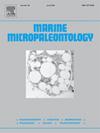Morphometric analysis of coccolithophore genus Reticulofenestra: Insights into taxonomy and evolution during late Eocene to early Oligocene
IF 1.5
4区 地球科学
Q2 PALEONTOLOGY
引用次数: 0
Abstract
The coccolithophore Reticulofenestra is key to understanding late Cenozoic climate change, but taxonomic identification remains challenging. This study uses morphometric and mixture analysis to evaluate taxonomic criteria for late Eocene to early Oligocene Reticulofenestra. The method enables a systematic comparison between the taxonomic morphotypes and the components recognized through Gaussian mixture modeling of parameters of distal shield length, circularity, and central opening ratio. At the species level, a total of nine morphotypes were studied from 6700 data points collected across three study sites in the mid–low latitude Atlantic–Indian Oceans. The results demonstrate that length and circularity effectively distinguish groups, validating their uses as primary taxonomic criteria. Nevertheless, central opening ratio exhibits high intra–group variability, limiting its standalone application. In addition, our integrated data reveal three evolutionary phases: (1) initial diversification during late Eocene cooling; (2) extinction following peak diversity after the Eocene–Oligocene Transition; and (3) early Oligocene stabilization reflecting adaptation in smaller species. This work provides statistical references for the validation of semi-quantitative morphologic descriptions, which may help establish a robust framework for identifying this ecologically vital lineage and enhance our understanding of phytoplankton responses to past environmental changes. Future genomic studies will be crucial for elucidating genotype-phenotype-environment relationships in Reticulofenestra evolution.
网状球石藻属的形态测量学分析:始新世晚期至渐新世早期的分类与演化
球石藻Reticulofenestra是了解晚新生代气候变化的关键,但分类鉴定仍然具有挑战性。本研究采用形态计量学和混合分析方法,对晚始新世至早渐新世网状蕨的分类标准进行了评价。该方法能够将分类形态与通过远端屏蔽长度、圆度和中心开口比参数高斯混合建模识别的组分进行系统比较。在物种水平上,从中低纬度大西洋-印度洋三个研究地点收集的6700个数据点中,共研究了9种形态。结果表明,长度和圆度可以有效地区分类群,验证了它们作为主要分类标准的用途。然而,中心开孔率表现出较高的组内变异性,限制了其单独应用。此外,我们的综合数据揭示了三个演化阶段:(1)始新世晚期冷却时期的初始多样化;(2)始新世-渐新世过渡后的生物多样性高峰灭绝;(3)早渐新世稳定,反映了小物种的适应性。本研究为验证半定量的形态描述提供了统计参考,有助于建立一个强大的框架来识别这一生态重要的谱系,并增强我们对浮游植物对过去环境变化的响应的理解。未来的基因组研究将是阐明网纹蝶进化中基因型-表型-环境关系的关键。
本文章由计算机程序翻译,如有差异,请以英文原文为准。
求助全文
约1分钟内获得全文
求助全文
来源期刊

Marine Micropaleontology
地学-古生物学
CiteScore
3.70
自引率
15.80%
发文量
62
审稿时长
26.7 weeks
期刊介绍:
Marine Micropaleontology is an international journal publishing original, innovative and significant scientific papers in all fields related to marine microfossils, including ecology and paleoecology, biology and paleobiology, paleoceanography and paleoclimatology, environmental monitoring, taphonomy, evolution and molecular phylogeny. The journal strongly encourages the publication of articles in which marine microfossils and/or their chemical composition are used to solve fundamental geological, environmental and biological problems. However, it does not publish purely stratigraphic or taxonomic papers. In Marine Micropaleontology, a special section is dedicated to short papers on new methods and protocols using marine microfossils. We solicit special issues on hot topics in marine micropaleontology and review articles on timely subjects.
 求助内容:
求助内容: 应助结果提醒方式:
应助结果提醒方式:


